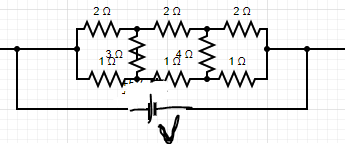
If we calculate the potential at both ends of these $3\,\Omega$ and $4\,\Omega$ resistors, that comes out to be the same. It is $V/3$ at both ends of the $3\,\Omega$ resistor and $2V/3$ at both ends of the $4\,\Omega$ resistor. So, we can safely say that because there is no potential difference, no current will be flowing through $3\,\Omega$ and $4\,\Omega$ resistors, so they can be removed from the circuit.
My question is simple and straight: Can we assume the above circuit consists of two balanced Wheatstone bridges, and straightaway remove the $3\,\Omega$ and $4\,\Omega$ resistors, without actually calculating the potentials at the ends? Because the ratio of resistances is the same (the required condition for a balanced Wheatstone bridge).
When I asked the same question to my physics teacher he said that the answer is coming by chance and we cannot consider it to consist of two balanced Wheatstone bridges. However, I am not convinced much so I decided to verify from Stack Exchange.
